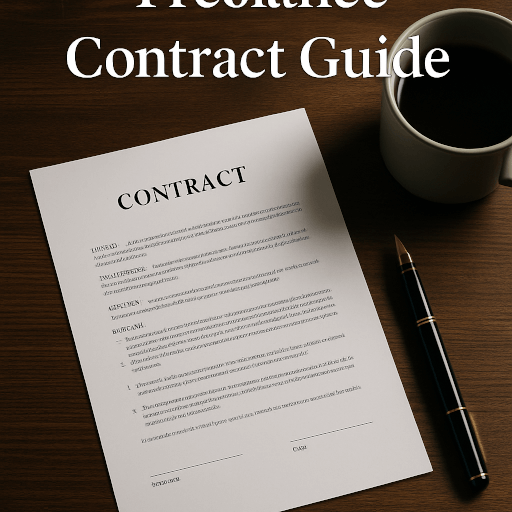That sinking feeling in your stomach when a client goes silent on an invoice. The slow, creeping dread as a “small tweak” turns into a full-blown project overhaul. If you’re a freelancer, these aren’t just hypotheticals; they’re common fears that can threaten your livelihood. While you’re an expert in your field, you may not be an expert in law. That’s where we come in.
This isn’t just another article listing generic contract clauses. This is your legal intelligence playbook from Legal Intel. We’re moving beyond the template to give you a strategic guide to crafting bulletproof freelance contracts. Our goal is to help you understand the ‘why’ behind each component, so you can preemptively solve problems, eliminate scope creep, and ensure you always get paid for your hard work.
The foundational anatomy of a freelance contract
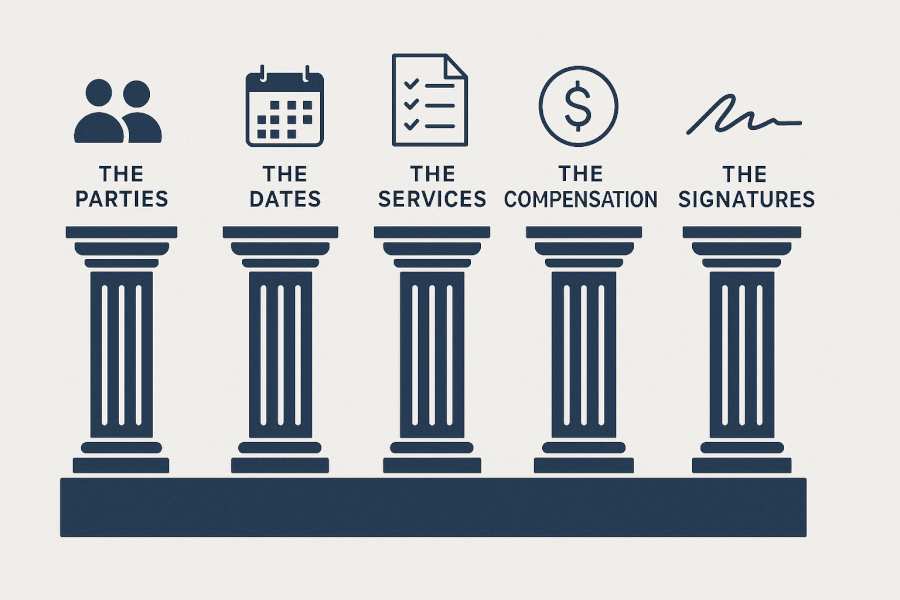
In the freelance world, a handshake agreement is the equivalent of building a house on a foundation of sand. It’s a business risk that leaves you vulnerable to misunderstandings, disputes, and non-payment. Moving from an informal email to a professional contract is the first step in treating your freelance practice like the serious business it is.
At its core, any legally sound agreement is built on a few key components:
- The parties: Clearly identifying everyone involved by their legal names and business names.
- The dates: Stating the effective date of the agreement and the projected timeline for the work.
- The services: A detailed description of the work to be performed.
- The compensation: The amount, method, and schedule of payment.
- The signatures: Proof that all parties have read, understood, and agreed to the terms.
A crucial function of your contract is to properly define the client-freelancer relationship. According to the U.S. Small Business Administration, there is a clear legal distinction between independent contractors and employees. Your contract should explicitly state that you are an independent contractor, responsible for your own taxes and benefits. This clarifies your role and protects the client from misclassification issues, reinforcing your professionalism.
Beyond the legalities, a contract has psychological power. Presenting a clear, comprehensive agreement sets a professional tone from day one. It signals that you are an organized, serious partner, and it establishes a framework of mutual respect for the work ahead.
Drafting for defense: critical clauses to prevent common freelance nightmares
A contract isn’t just a formality; it’s your primary defensive tool. The following clauses are designed to address the most common freelance pain points head-on, from scope creep to non-payment.
The scope of work (sow): your single source of truth
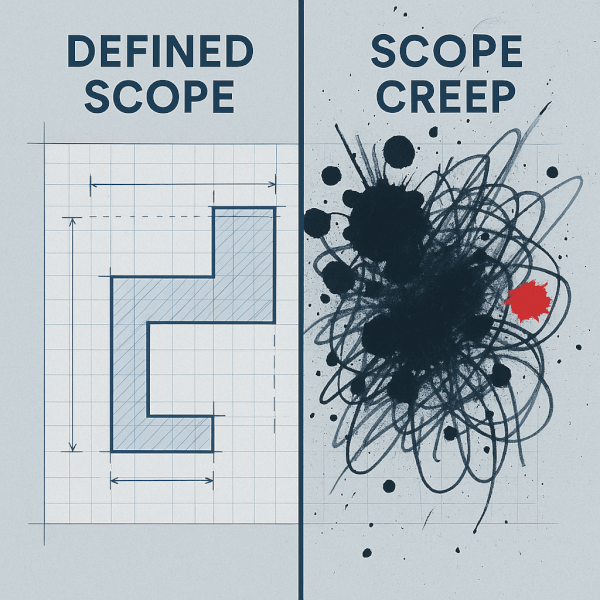
This is arguably the most important section of your entire contract. An ambiguous SOW is an open invitation for “scope creep”—the slow expansion of project requirements beyond the original agreement. To prevent this, your SOW must be meticulously detailed.
- Define deliverables: Don’t just say “website design.” Specify “Homepage mockup in Figma, one round of revisions, five internal page designs (About, Services, Contact, Blog, FAQ), and final delivery of layered design files.” Be painfully specific about what you are actually providing.
- The revision process: Scope creep often hides in endless feedback loops. Clearly define the number of revision rounds included in the fee (e.g., “two rounds of revisions”). Specify that any additional revisions will be billed at your standard hourly rate.
- Exclusions: Just as important as what’s included is what is not. Explicitly state what is out of scope. For a writer, this might be “This agreement does not include sourcing or purchasing stock photography.” For a developer, it could be “This project does not include ongoing website maintenance or hosting services.”
Payment terms: how to guarantee you get paid on time
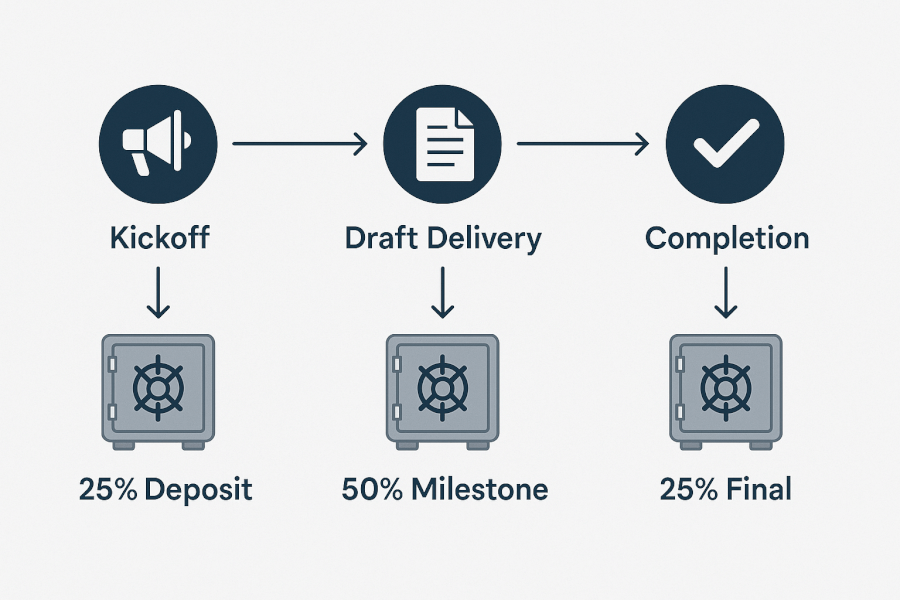
Chasing invoices is stressful and unprofessional. A well-defined payment clause is your best tool for ensuring timely compensation.
- Structure your fees: Never agree to 100% payment upon completion for a large project. Instead, structure your payments to maintain cash flow and reduce your risk. A common structure is a deposit to start, milestone payments at key stages, and a final payment upon completion.
- The late payment clause: Don’t be afraid to include penalties for late payments. This clause should state that invoices are due within a specific timeframe (e.g., “Net 15” or “Net 30”) and that overdue invoices will accrue interest (e.g., “a late fee of 1.5% per month on the outstanding balance”). This practice is supported by legal frameworks like NYC’s Freelance Isn’t Free Act, which gives freelancers legal recourse for non-payment.
- Accepted payment methods: Specify how you accept payment (e.g., bank transfer, Stripe, PayPal) and who is responsible for any processing fees.
- The ‘kill fee’: What happens if the client cancels the project halfway through? A termination clause with a “kill fee” ensures you are compensated for the work you’ve already done. This is typically a percentage of the total project fee (e.g., 25-50%) or a non-refundable deposit.
| Milestone | Deliverable | Payment Due |
|---|---|---|
| Project Kickoff | Signed Contract | 25% Deposit |
| Draft Delivery | Submission of First Draft | 50% of Total Fee |
| Project Completion | Final Approved Deliverables | 25% Final Balance |
Intellectual property (ip) rights: defining ownership
Confusion over who owns the final work can lead to serious disputes. By default, as the creator, you own the copyright to the work you produce unless you explicitly transfer it.
- IP ownership clause: Your contract must clearly state when the intellectual property rights transfer to the client. The best practice is to state that ownership is transferred only after the final payment has been received in full. This gives you significant leverage in case of non-payment.
- Portfolio rights: Be sure to include a clause that grants you the right to display the work in your professional portfolio (e.g., on your website or social media). Without this, you could be prevented from showcasing your best projects to attract future clients.
“A well-drafted contract isn’t a sign of mistrust; it’s a sign of professionalism. It serves as a shared roadmap that keeps both the freelancer and the client aligned, preventing misunderstandings before they start.” – Legal Expert at Legal Intel
From template to tailored agreement: a practical guide
A generic, one-size-fits-all template downloaded from the internet is a starting point, not a solution. Every project is unique, and your contract should reflect that. A contract for a freelance writer will have different IP considerations than one for a web developer, who needs to think about code licenses and hosting.
Here is a step-by-step process for customizing a base template for any project:
- Start with a solid base: Use a reputable template from a source like the Freelancers Union or a legal services provider.
- Fill in the blanks: Enter the client’s legal name, your legal name, and the effective date.
- Detail the SOW: Write a comprehensive Scope of Work section, including specific deliverables, revision limits, and exclusions.
- Adjust payment terms: Define the total project fee, payment schedule (deposit, milestones), late fee penalties, and accepted payment methods.
- Clarify IP rights: Specify when ownership transfers and explicitly reserve your portfolio rights.
- Review with the client: Send the draft to the client and be prepared to walk them through it and answer any questions. This transparency builds trust.
- Sign it: Use a digital signature service like PandaDoc or Bonsai to make the process easy and create a legally binding record.
While you can handle most standard agreements yourself, you should always consult a lawyer for high-stakes projects, such as those with large budgets, complex IP issues, or long-term commitments.
Enforcing your contract: what to do when things go wrong
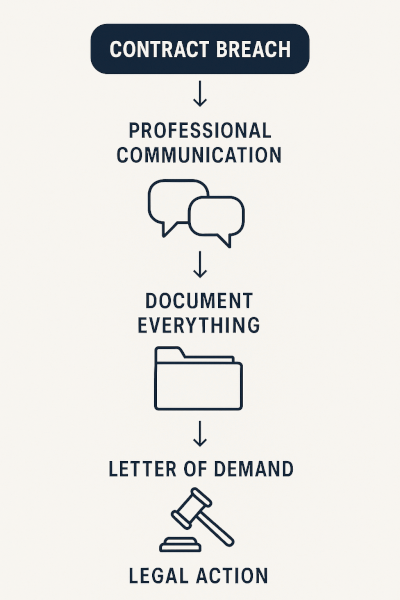
Even with a perfect contract, disputes can happen. If a client breaches the agreement, your contract provides the roadmap for resolving the issue.
- Professional communication: The first step is not to threaten legal action. Politely and professionally communicate with the client, referencing the specific clause in the contract that has been breached. For example, “Hi [Client Name], per our contract, the second milestone payment was due on [Date]. Please let me know when I can expect to receive it.”
- Document everything: Keep a detailed paper trail. Save all emails, meeting notes, and records of out-of-scope requests or missed deadlines. This documentation is critical if you need to escalate the issue.
- Follow the dispute resolution clause: Your contract should have a clause that outlines the steps for resolving a disagreement. This often specifies mediation or arbitration as a less costly first step before litigation.
- Send a formal letter of demand: If communication fails, the next step is to send a formal letter of demand via certified mail. This letter should clearly state the breach, reference the contract, and specify the amount owed and a deadline for payment.
- Consider legal action: For non-payment, small claims court is often the most practical option for freelancers. The process is designed to be accessible without a lawyer. As detailed in the legal analysis of freelance worker laws by the Syracuse Law Review, new legal protections are making it easier than ever for freelancers to enforce their contracts and claim damages.
The future of freelance agreements: leveraging tools and technology
The world of freelancing is evolving, and so are the tools we use to manage our businesses. Staying ahead of the curve can provide a significant professional advantage.
- Smart contracts: Blockchain technology is enabling the rise of smart contracts, which can automatically trigger payments from an escrow account as soon as specific deliverables are met, virtually eliminating the risk of non-payment.
- AI-powered analysis: Emerging AI tools can now analyze your contracts to identify potential risks, ambiguous language, or missing clauses, acting as a digital legal assistant.
- Integrated platforms: All-in-one freelance platforms are combining proposals, contracts, project management, and invoicing into a single, seamless workflow. This integration saves time and reduces the chance of administrative errors.
As the freelance economy grows, so do the regulations designed to protect it. Staying informed about new laws and worker protections will ensure your contracts remain compliant and enforceable, positioning you as a forward-thinking and legally savvy professional.
Frequently asked questions about freelance contracts
What makes a freelance contract enforceable?
A freelance contract is enforceable if it contains clear terms, mutual agreement (offer and acceptance), consideration (something of value, like payment), and is for a legal purpose. Both parties must have the legal capacity to enter into the agreement, and it must be signed.
What should be included in a freelance agreement?
A freelance agreement should include the names of both parties, a detailed scope of work, clear payment terms, the project timeline and deadlines, a clause on intellectual property rights, a termination clause detailing what happens if the project ends early, and a dispute resolution process.
How do you legally enforce a freelance contract?
You can legally enforce a freelance contract by first sending a formal demand letter for the breach. If that fails, you can pursue mediation or arbitration as defined in your dispute resolution clause. Finally, you have the option of filing a lawsuit, often in small claims court, to recover unpaid fees or damages.
What is the most important clause in a freelance contract?
While all clauses are important, the Scope of Work (SOW) is arguably the most critical. It defines the exact deliverables, timelines, and revision limits. A clear SOW is the single best tool for preventing scope creep, which is the root cause of many freelance disputes.
Conclusion: your contract is your most valuable business tool
A contract is not about preparing for conflict; it’s about creating clarity. It is a document of alignment that protects both you and your client, ensuring everyone is on the same page about expectations, deliverables, and payment.
Moving “beyond the template” to craft a strategic, tailored agreement is the hallmark of a professional freelancer. It demonstrates that you value your work, respect your client’s investment, and are serious about building a sustainable, successful business. Your contract is more than just a legal document—it’s your most valuable tool for building a secure and profitable freelance career.
For more expert insights and legal intelligence to protect and grow your freelance business, subscribe to the Legal Intel weekly briefing.
